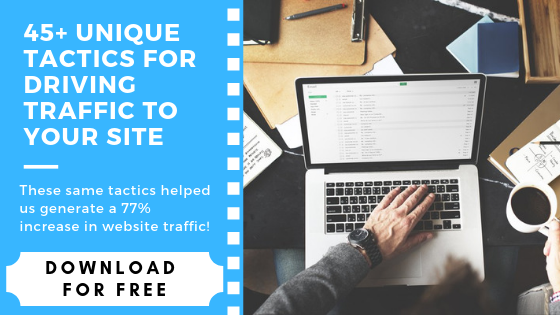Competitive intelligence can provide crucial information when it comes to business growth. But what does it mean?
What if you had the power to know what your competitors are doing in terms of driving traffic, leads, and revenue? What would that do for you?

Here’s the short answer. Your business can save a lot of time in market research and planning (which is a crucial part of any organization.) You can uncover what kind of words to use to talk to your audience, new traffic tactics, and generate marketing copy that converts visitors into buyers.
In almost all business categories, there are existing successful companies you can tap into to generate competitive intelligence.
So, where do you start and how do you get started?
Facebook and Twitter
Facebook and Twitter have a feature where you can see any ads a business is currently running. It will show you:
- Ad copy (see how these brands generate conversion with marketing copy)
- Images (see what kind of imagery connects with the audience)
- Landing pages that are driving ad traffic (you can analyze this page to see how it's optimized for conversions)
Note: Facebook added this layer of transparency after the Cambridge Analytica scandal and all the "fake news" material circulating online. Twitter soon followed their footsteps.
How to get started
To start, create a list of 3-5 online competitors and brands, and find their Facebook page. If they don't have a Facebook page or Twitter, try a save them for a later time and to find new competitors.
Next, go onto their Facebook page and click on 'Info and Ads' on the left side. If they're running ads, you should be able to see them here.
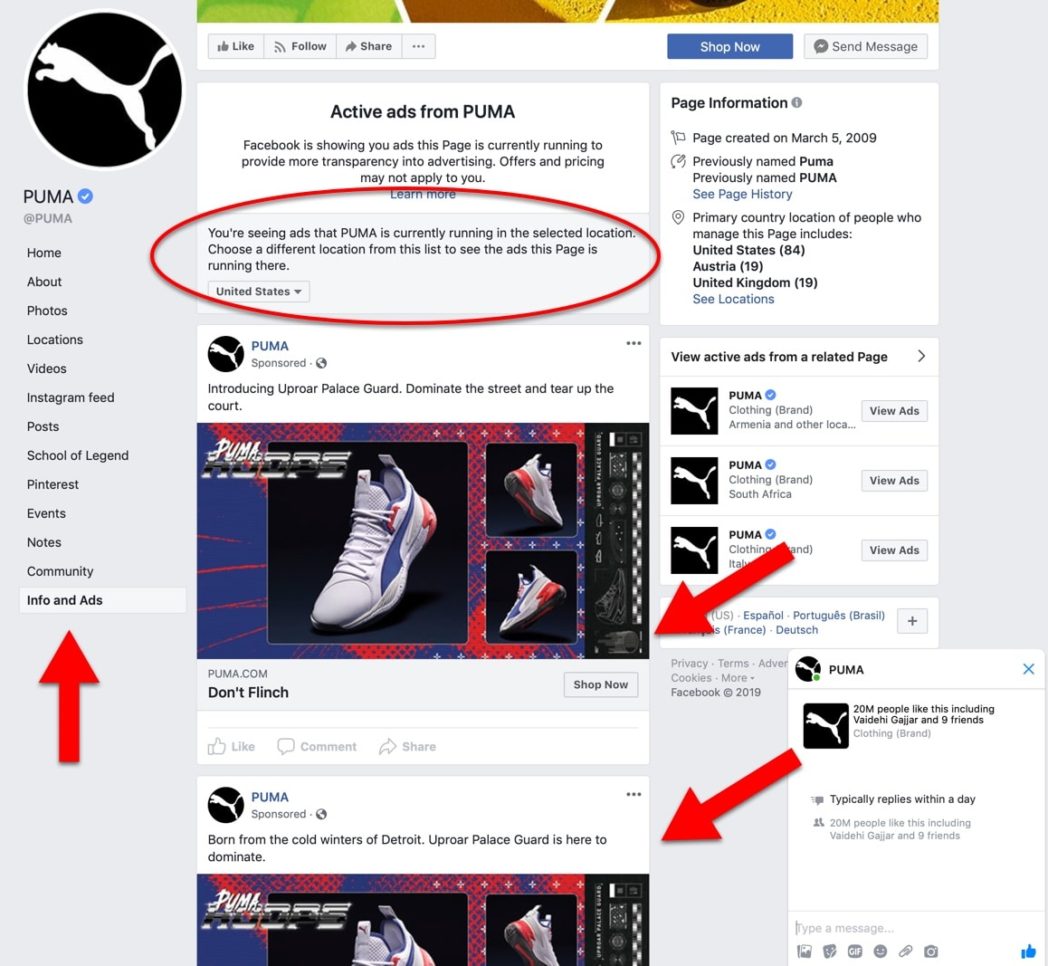
Benefits of looking at your competitors ad copy.
- Uncover successful and unsuccessful marketing material such as copy and imagery
- Provides you with a starting point for developing your own effective marketing strategy
- Determine the level of competition your business is posing
- Highlight and learn from your competitors' mistake
- Identify market gaps and generate opportunities to position yourself in front of your competition
At our fingertips now, we have our competitions marketing strategy, and we can determine if they've been successful or unsuccessful. This gives us strategic insight on how (and if) our competitors are driving leads and revenue.
ICYMI: Here's How You Can Start a Business in Under 30 Days
A practical example:
Let's just take the clothing and shoe company Puma for an example. We can directly go into Facebook page and click ‘Info & Ads’. (See above image)
We can see they’re running multiple ads, so it might be a good idea to start copying and pasting their text into a word document to see how their messaging aligns.
Hit the pause button for a second.. At this moment, what insight can we generate?
- If they’re not running any ads, this means that it is either ineffective or they haven’t mastered Facebook ads themselves
- If they have multiple ads running, this could suggest ads are a integral part of their marketing campaign and generate high ROI for them
- If they have multiple ads with similar copy, this could suggest they’re in the middle of a campaign and we can leverage strategic insight from here
At this point, we have all the information we need from them in terms of marketing copy, imagery, and targeting on Facebook.
To take everything a layer deeper... we can specifically click on the ads and now see what landing pages these brands are promoting.
You can analyze the landing page a million different ways. How the page is set up? Do they have pixels and other ads running to the page? Can we start uncovering their marketing funnel? What do their call-to-actions and buttons look like? Is it mobile friendly and how fast does it load?
You have all the data at your fingertips, now is where your strategic creativity comes in.
We'll keep it simple for this example. In the Puma example above, the first two ads are about Puma's basketball shoes. This means:
- They're testing 2 Facebook Ads for the same landing page (probably A/B versions) We can take a screenshot now and check back at a later date to see which ad copy won, which would suggest it's generating conversions and results
- The marketing copy they used was short. Was this intentional? Are they trying to position themselves as 'elegant' or are maybe they're not experienced well with Facebook Ads
- They use the CTA for 'Shop Now'. How does this CTA translate onto their landing page? Are they using the same CTA or different one?
- They use only one image. Wouldn't they want to incorporate video? What do we know about this ad funnel currently? Does it make sense they're using one image?
You can continue this process for each ad, breaking down each element to analyze for competitive intelligence. It's cliche, but there's no dumb question when it comes to analyzing your competitors' ads.
Analyzing the Landing Page
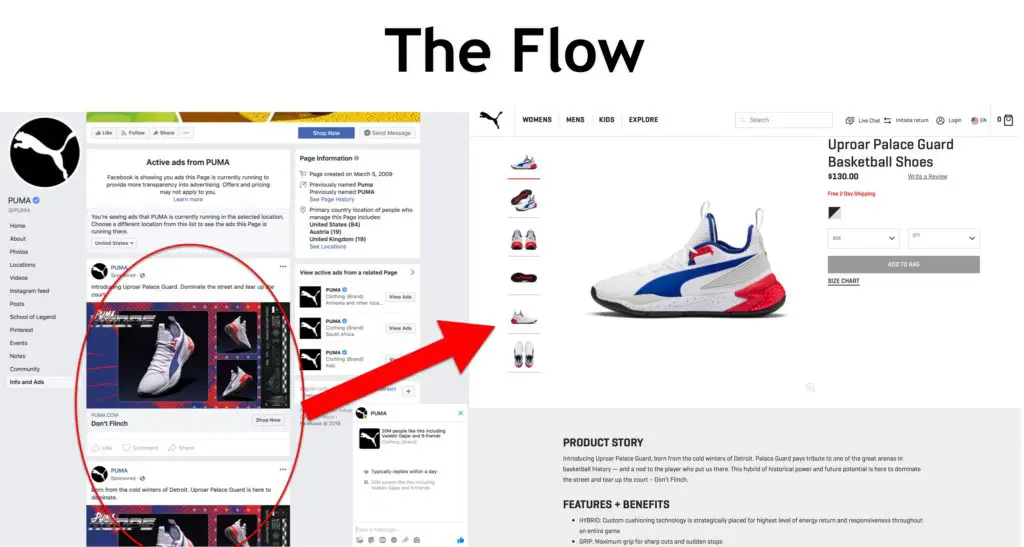
On the landing page, we can clearly see that they have multiple shots of the shoe and additional marketing copy below the images. How come they didn't use this on their ads? Are there marketing blurbs we can leverage for ourselves?
If Puma was our competitor, you can see what angles to take the shots of the shoe, what features they're highlighting, and even analyze the price points.
Whatever the competitors are talking about on their landing page, you can take it and strategically leverage it for yourself. You just have to think outside the box and see how you can position yourself in front of your competitor.
Audience Insight
At this point, we can see ads, imagery, and landing pages for our competitors. To add another layer deeper, we can start analyzing the marketing copy (we previously copied and pasted from above) to see what potential keywords these brands are using. We can take the text and throw it in a word cloud generator.
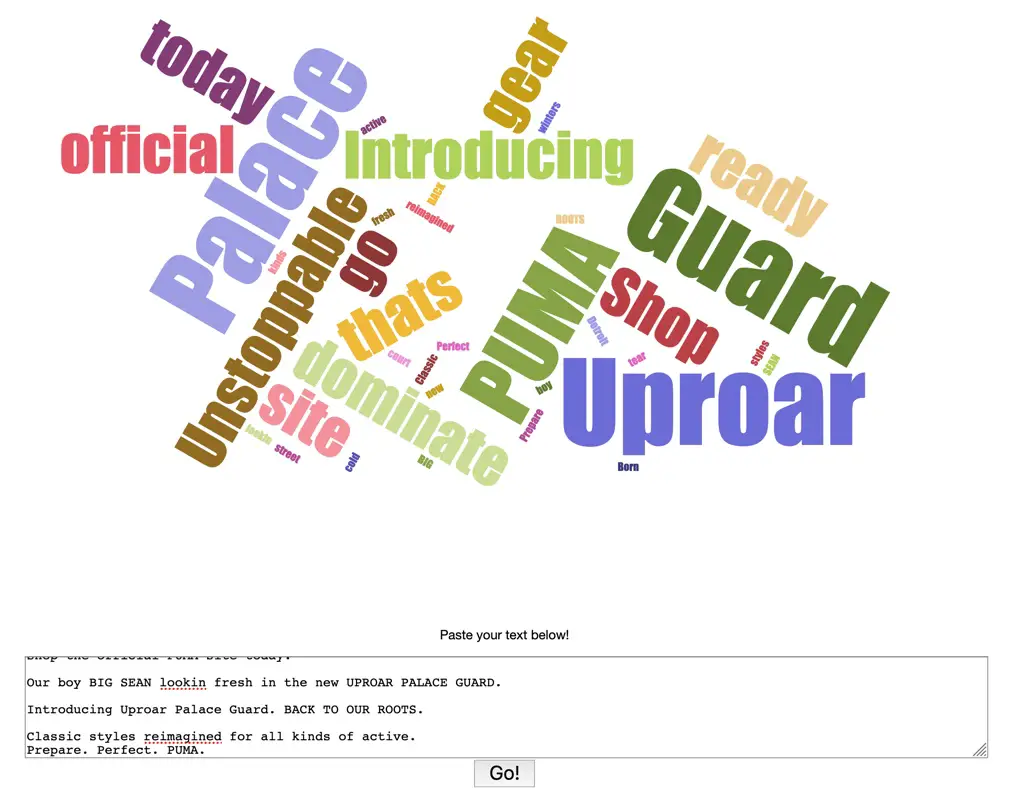
Click here to use the word cloud generator from above.
Since Puma didn't use a lot of copy, this might not be the best example. But we can see the words guard, introducing, unstoppable, are some that stick out.
Combining this with the imagery on the ads and landing page, the information we have could suggest is that they're launching a new shoe line and we might be analyzing Puma during a testing phase.
We could also take the marketing copy from the landing page and throw it in the word generator to try and find more insight.
As astute marketers, you want to ask questions like:
- What type of words or phrases can I highlight using the word cloud generator?
- Is there any additional marketing copy we can extract that helps address pain points my target audience has?
- Are there any other trends we can glean insight from?
Lead Generation
One of the great benefits you'll get out of this tactic is the ability to create an offer based on your competitor’s success. We've dissected their ad funnel, we've analyzed their marketing copy, and we have access to their landing page. How do we use this data for lead generation for ourselves?
First, see if they're driving traffic to their site by checking their Alexa rank. Click here to find how much traffic any website is generating. Note: this is a rank, so the lower the number (closer to 1,) the more traffic they're generating.
At this point, it's putting the puzzle pieces together. If a website has a high amount of traffic flowing, and we have their marketing funnel uncovered; what's stopping us from doing the same?
And by doing this simple exercise, we've increased our efficiency! We've saved a tremendous amount of planning time, we don't have to start from scratch, and we can improve our own site to position ourselves in front of our competitors!
Additional Benefits
Another way to stay on top of your competitors is to see what types of ads they’re running on a consistent basis. We could check this weekly, monthly, or whatever fits our schedule.
Theoretically, we can now start breaking down their ad strategy even deeper. If you see the same ad running for weeks or even months, this clearly suggests our competitors are finding a high ROI in it.
We can also monitor to see how the ads progress.
- Maybe they refined their messaging over the course of a couple of weeks, which means we should update ours depending on the results we've been seeing.
- Maybe they redid their whole strategy and are going after a new approach, which could serve as a warning system for us to update our marketing tactics.
- Maybe they have a new series of ads that sheds more insight on their marketing funnel.
There are a ton of benefits a business can use for competitive intelligence when it comes to Facebook Ads.
Instagram and Twitter
Facebook isn’t the only platform that allows ad transparency. Both Instagram and Twitter have free tools to see if a business is running ads.
We follow the same footsteps above, but this time uncover Instagram Ads and Twitter Ads.
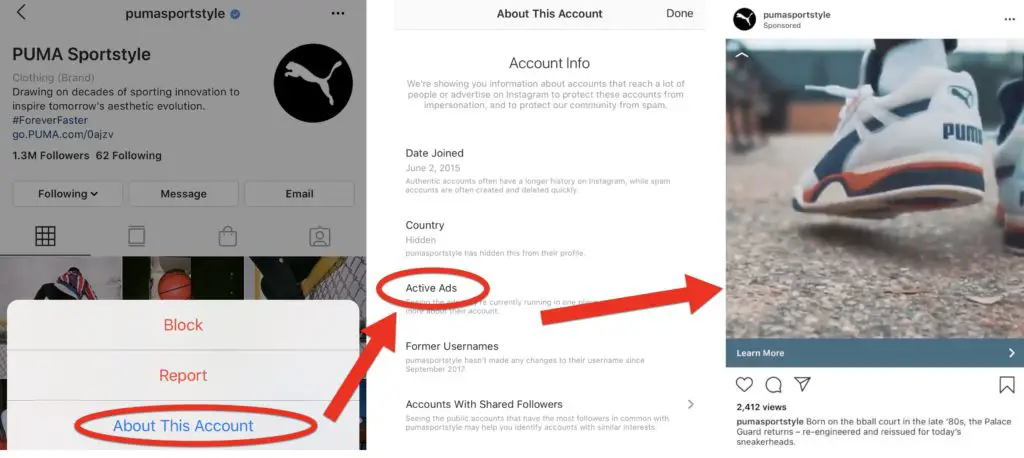
To check if a business is running ads on Instagram, follow the instructions below:
- Open Instagram and select a business’s page
- Click the three dots on the top right “…” and select ‘About This Profile’
- Click ‘Active Ads’
To check if a buinsess is running ads on Twitter, follow the instructions below:
- Visit https://ads.twitter.com/transparency
- Enter the Twitter handle of a business or company on the top right where it says ‘Search advertisers’
- You’ll now see all ads running by the company
Note: Twitter only shows tweets that have been promoted in the last 7 days.
Additional Competitive Intelligence Insight
Data drives results, and the way it drives results is by highlighting trends. In this context, let’s look at at a hypothetical scenario.
What if you saw a competitor is running more Twitter ads than Facebook or Instagram? And let's assume they’re driving results since their Alexa rank suggests they have high traffic to their website.
What this suggests to us is that the competitor sees the most results through Twitter. What does this mean for us?
It could mean that maybe we need to focus more on Twitter ads than on Facebook or Twitter. If they have traffic, then the data suggests they must be doing something right.
The point is, be sure to look at all their social ad efforts as a whole picture versus focusing on just one social media channel or just one ad.
Wrapping Up
Social media is important part of every business. And this is an excellent start for sustainable growth if you're just starting out. (And don't forget, this is all free insight!)
Generating competitive intelligence at this level allows you to:
- Uncover successful and unsuccessful marketing material such as copy and imagery
- Provides you with a starting point for developing your own effective marketing strategy
- Determine the level of competition your business is posing
- Highlight and learn from your competitors' mistake
- Identify market gaps and generate opportunities to position yourself in front of your competition
Instead of starting ads from scratch and testing out different images, copy, and headlines; you’re now starting a higher strategic level which should save you a ton of time on the marketing side.
If you have any questions or enjoy our content, let us know in the comments below!
Be sure to check out the articles below for additional marketing insight:
- 20 LinkedIn Marketing Tips To Help You Grow Your Business
- The Twitter Page Template That Helped Me Gain 40k Followers
- 24 Tips To Help You Maximize Your Twitter Marketing Strategy
- 36 Facebook Marketing Tips To Help Maximize Your Efforts
- How To Create A Business Page On Instagram To Attract More Customers

